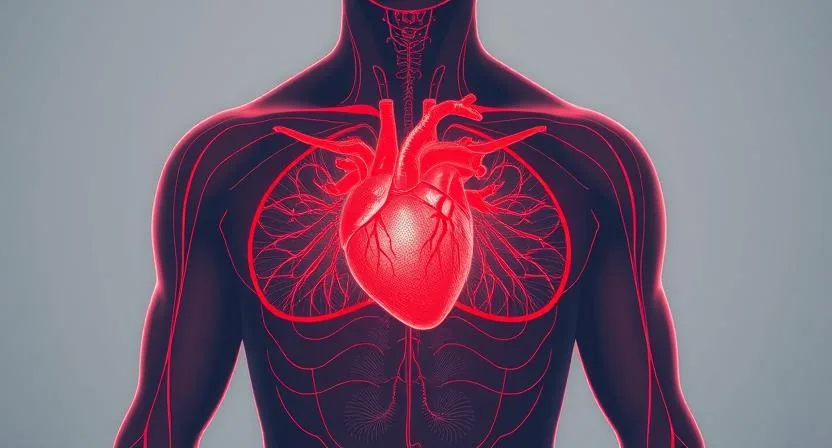It has been proven by ancient and modern medical research that exercise is a great activity that can help a person stay healthy and energetic throughout their lives. If this practice is done regularly for at least five days a week, it improves overall fitness, strengthens muscles, and helps build strong bones.

Benefits of Regular Exercise
Exercise can also significantly reduce the risk of diseases that negatively affect the health of one of the most important organs of the human body, the heart, such as high blood pressure, high cholesterol, and obesity.
But remember, if a person starts exercising excessively and abandons the path of moderation, this extreme exercise can turn even a seemingly humane practice like exercise into something physically and mentally harmful. This practice specifically affects the heart, creating a medical disorder called “athletic heart.”
How Much Is Too Much?
When a person starts exercising, the question naturally arises in their mind: How much exercise should they do per day to gain health and wellness? And also what kind of exercise is necessary? Many people also want to know what the dangers of exercise can be and what happens if they exercise too much.
The American Heart Association, the leading heart disease organization in the United States, generally recommends 150 minutes of moderate-intensity exercise (such as brisk walking) or 75 minutes of vigorous-intensity exercise (such as running) per week. It also recommends muscle-strengthening exercises at least two days per week.
When a person exercises more than these guidelines, their heart begins to adapt to the new routine. That is, the size and shape of the heart begins to change. As a result, the way the heart works can also change.
The changes that affect the structure and performance of the heart of people who exercise a lot are called “athletic heart” or “athlete’s heart.”

Types of Exercise: Dynamic vs. Static
Exercise is generally divided into two main types: dynamic and static.
Dynamic Exercises
These are exercises that force the heart to pump more blood to the body to keep up with the activity. Running, skiing, playing soccer, or hockey are examples of dynamic exercises. For example, when you run, your heart can pump three to five times more blood than it does at rest.
Static Exercises
These types of exercises include weightlifting, gymnastics, or rock climbing, which require the muscles to lift or pull heavy weights. The heart supplies more blood to the muscles of these exercisers, but success in this case depends on muscle strength, not blood flow.
For example, if you do arm exercises (curls) with dumbbells, the muscles in that part of the body must be strong enough to lift the weight.
Joint Exercises
Some exercises, such as rowing or cycling, have characteristics of both types. They not only require the heart to pump a large amount of blood (dynamic), but also require the muscles to exert constant force (static).
How Different Exercises Affect the Heart
As mentioned, the heart adapts in different ways over time depending on the type of exercise. Dynamic exercises increase the amount of blood flow through the heart, which can increase the size of the heart. Static exercises increase the pressure on the heart, which can thicken the heart walls.
Read about more Exercise & fitness tips here.

What is an Athletic Heart Condition?
When a person exercises excessively for a long period of time, their heart undergoes structural and functional changes, such as an increase in size or thickening of the walls. This condition is called an “athletic heart.”
This condition is usually not dangerous and is often found in trained athletes. That is why it is called an athletic heart. But even an ordinary person who exercises a lot can suffer from this medical condition. Sometimes it can increase the risk of certain heart problems, so it is important to get it checked out, especially if symptoms appear.
Potential Problems Associated with Athletic Heart
All those women and men who exercise more than the general guidelines for exercise, such as exercising more than an hour a day, are likely to develop an athletic heart condition.
Who is Most Likely to Have an Athletic Heart?
This medical disorder commonly occurs in athletes who perform endurance-enhancing exercises, such as:
- Runners participating in the marathon
- Men and women participating in long-distance races
These athletes exercise for several hours a day and more than 12 to 15 hours a week.
How Does the Heart Change?
When runners spend most of their day running, their heart size increases, specifically the chambers of the heart become larger to pump more blood. The heart changes differently in weightlifters or men and women who lift weights. Their heart walls become thicker because weightlifting puts more pressure on the heart.
What are the Possible Problems With an Athletic Heart?
Although this medical disorder is often the result of healthy activities, namely exercise, it can also pose some risks:
Atrial Fibrillation
Men and women whose hearts enlarge due to intense exercise may develop atrial fibrillation. In this medical condition, the heart beats abnormally fast. This abnormal or unnatural heartbeat is usually found in older people, patients with high blood pressure, or heart disease.
Why Does This Happen?
Inflammation or scar tissue in the upper chamber of the heart (atrium) can cause atrial fibrillation. Stress and negative environmental factors can also play a role.
Coronary Artery Calcification
This is the process of calcium deposits in the arteries of the heart that usually develop in older people or those at risk of heart disease. This medical condition increases the risk of heart attack or stroke.
Do Athletes Also Get Coronary Artery Calcification?
Yes, some high-level athletes have been found to have calcium deposits in their heart arteries. But fortunately, research has shown that despite calcium deposits, athletes are not at increased risk of heart attack or death.
For example, a large study of 22,000 men and women in the United States found that athletes who exercised a lot and had high levels of coronary artery calcification had a negligible risk of dying from heart disease.
Do Athletes Need Medication or Treatment
Some athletes may be concerned about whether they should take medications like aspirin or statins during their training. But each individual’s risk is different. So if someone has concerns about coronary artery calcification or heart health, they should definitely seek advice from a doctor.
The Importance of Balanced Exercise
Although the risk of developing athletic heart disease may be increased in high-level athletes, exercise is undoubtedly one of the best ways to maintain a healthy lifestyle. For example, if a person does not exercise regularly, their heart may become stiff and not be able to pump blood as effectively as before.
A flexible heart expands more during filling and pumps more blood out with each beat. In contrast, a stiff heart has difficulty filling with blood and becomes weaker at pumping blood around the body.

Running: One of the Best Exercises for Heart Health
This exercise helps keep the heart young when done regularly. Generally, doing it continuously from youth to old age keeps the heart strong and flexible. Even if a 40 or 50-year-old person starts running and other regular exercises, they can significantly reduce the negative and harmful health effects of a sedentary lifestyle.
For example, a 2018 study involved sedentary people, most of whom were around 50 years old. In the study, people who followed a regular exercise program that included running, cycling, and elliptical machine exercise for two years had more resilient hearts than those who didn’t exercise.
Remember, it’s never too late to start exercising even in old age. Following the guidelines of regular exercise promotes physical and mental health. In particular, the two most important organs of the human body, the heart and the brain, remain healthy and young throughout life.


